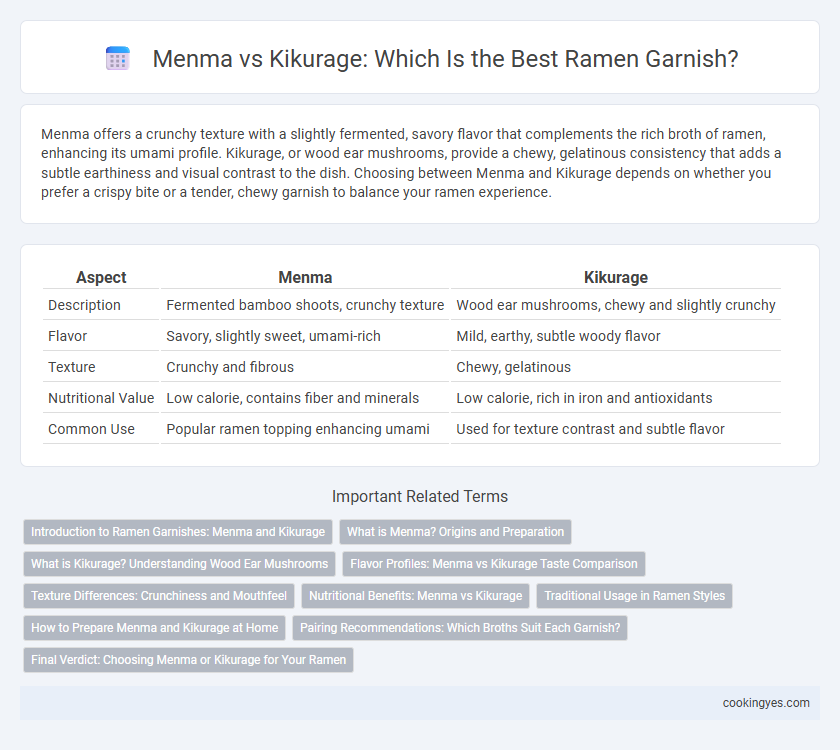Menma offers a crunchy texture with a slightly fermented, savory flavor that complements the rich broth of ramen, enhancing its umami profile. Kikurage, or wood ear mushrooms, provide a chewy, gelatinous consistency that adds a subtle earthiness and visual contrast to the dish. Choosing between Menma and Kikurage depends on whether you prefer a crispy bite or a tender, chewy garnish to balance your ramen experience.
Table of Comparison
| Aspect | Menma | Kikurage |
|---|---|---|
| Description | Fermented bamboo shoots, crunchy texture | Wood ear mushrooms, chewy and slightly crunchy |
| Flavor | Savory, slightly sweet, umami-rich | Mild, earthy, subtle woody flavor |
| Texture | Crunchy and fibrous | Chewy, gelatinous |
| Nutritional Value | Low calorie, contains fiber and minerals | Low calorie, rich in iron and antioxidants |
| Common Use | Popular ramen topping enhancing umami | Used for texture contrast and subtle flavor |
Introduction to Ramen Garnishes: Menma and Kikurage
Menma and Kikurage are popular ramen garnishes that enhance texture and flavor complexity in traditional Japanese ramen dishes. Menma, made from fermented bamboo shoots, provides a crunchy, slightly sweet, and umami-rich bite, while Kikurage, or wood ear mushrooms, offers a chewy texture with a subtle earthy taste. Both ingredients are essential for balancing the overall ramen experience by complementing the broth and noodles with unique mouthfeel contrasts.
What is Menma? Origins and Preparation
Menma is a traditional Japanese ramen topping made from fermented bamboo shoots, prized for its crunchy texture and savory umami flavor. Originating from Chinese fermented bamboo shoot recipes, Menma undergoes a fermentation and seasoning process that enhances its rich, slightly tangy taste, differentiating it from other garnishes like Kikurage, which is a type of edible wood ear mushroom known for its gelatinous texture. Menma's distinctive flavor profile and preparation method make it a staple garnish that complements the broth and noodles, adding depth and complexity to ramen dishes.
What is Kikurage? Understanding Wood Ear Mushrooms
Kikurage, also known as wood ear mushrooms, is a popular ramen garnish prized for its crunchy texture and mild earthy flavor, providing a distinct contrast to the rich broth. Unlike Menma, which is fermented bamboo shoots with a savory and slightly sweet taste, Kikurage offers a unique, jelly-like bite that enhances the overall ramen experience. Rich in fiber and nutrients, Kikurage adds both textural variety and health benefits to traditional Japanese ramen bowls.
Flavor Profiles: Menma vs Kikurage Taste Comparison
Menma offers a savory, slightly sweet, and fermented bamboo shoot flavor that adds a crunchy texture and umami depth to ramen. Kikurage, or wood ear mushrooms, provide a subtle earthy taste with a delicate, gelatinous crunch that contrasts Menma's firmness. Choosing between Menma and Kikurage depends on whether you prefer a bold, tangy accent or a mild, textured complement to the broth.
Texture Differences: Crunchiness and Mouthfeel
Menma offers a firm, crunchy texture that adds a satisfying bite to ramen, enhancing each spoonful with its slightly fibrous consistency. Kikurage, or wood ear mushrooms, provide a unique, gelatinous crunch that is lighter and more chewy, contributing a subtle contrast in mouthfeel. The interplay between Menma's robust crunch and Kikurage's delicate chewiness creates a dynamic texture profile that elevates the overall ramen experience.
Nutritional Benefits: Menma vs Kikurage
Menma, made from fermented bamboo shoots, is rich in dietary fiber, vitamins B and E, and essential minerals such as potassium and manganese, supporting digestive health and nutrient absorption. Kikurage, or wood ear mushrooms, offer a high content of iron, calcium, and collagen, promoting blood health and skin elasticity. Both garnishes enhance ramen's nutritional profile by contributing unique vitamins and minerals, with menma providing fiber and Kikurage delivering collagen and mineral density.
Traditional Usage in Ramen Styles
Menma, fermented bamboo shoots, is traditionally used in Shoyu and Shio ramen styles, providing a crunchy texture and savory umami flavor that complements the clear broth. Kikurage, or wood ear mushrooms, are commonly found in Tonkotsu ramen, adding a chewy texture and subtle earthiness that balances the rich, creamy pork bone broth. Both garnishes enhance the ramen experience by aligning with the distinct flavor profiles and textures of their respective traditional styles.
How to Prepare Menma and Kikurage at Home
Menma, fermented bamboo shoots, require soaking and boiling to reduce saltiness and soften their texture before slicing them thinly for ramen garnish. Kikurage, or wood ear mushrooms, need thorough rinsing and brief soaking to rehydrate, then can be quickly blanched or stir-fried to enhance their crunchy texture. Both garnishes add distinct flavors and textures, with menma's umami-rich savoriness complementing ramen broth and kikurage's unique crunch providing contrast.
Pairing Recommendations: Which Broths Suit Each Garnish?
Menma, made from fermented bamboo shoots, pairs exceptionally well with rich, oily tonkotsu broths, as its salty and umami flavors complement the creamy pork base. Kikurage, or wood ear mushrooms, offers a crunchy texture and mild earthiness that enhances lighter, clear shoyu or shio broths by adding contrast without overpowering the delicate flavors. For a balanced ramen experience, choose menma with robust, hearty broths and kikurage with subtle, savory soups to optimize taste and texture harmony.
Final Verdict: Choosing Menma or Kikurage for Your Ramen
Menma, fermented bamboo shoots, offer a crunchy texture and a slightly sweet, umami-rich flavor that complements rich tonkotsu and shoyu ramen broths. Kikurage, or wood ear mushrooms, provide a subtle earthiness with a gelatinous, chewy bite that enhances lighter broths like shio or miso ramen. Selecting Menma or Kikurage depends on desired texture contrast and flavor balance; Menma pairs best with robust, hearty ramen, while Kikurage excels in adding a delicate crunch and mild depth to lighter soup bases.
Menma vs Kikurage for ramen garnish Infographic

 cookingyes.com
cookingyes.com